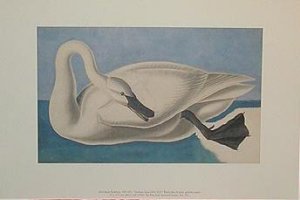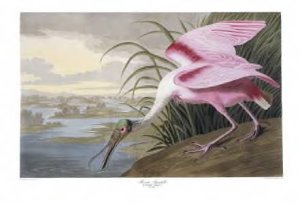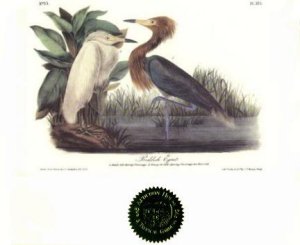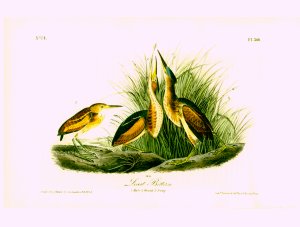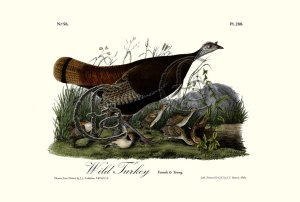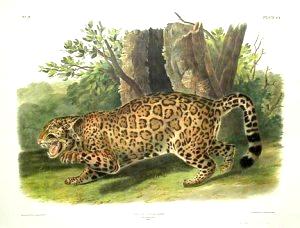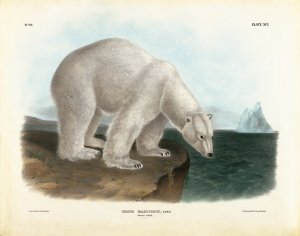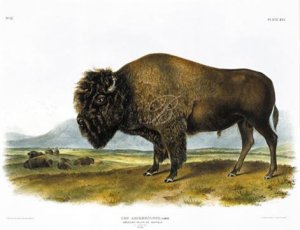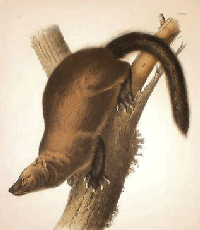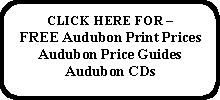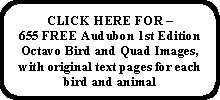|
Modern Audubon Folio and Octavo Editions by Ron Flynn Until recently, there were few smaller octavo to folio sized high quality Audubon print editions. Within the past few years, a number of new editions have been published. Today, there is a wide variety of high quality Audubon prints for those people who do not have the space to frame and display a full double elephant folio (DEF) sized print. I have included in this article all editions, that I know of, that are considered high quality collectible prints, and not cheap reproductions or decorator art. This article is a companion to my Modern Audubon Birds of America D.E.F. Editions - a complete review article found on this website. Between the two articles, all modern Audubon editions, with collectible quality and value, are reviewed and discussed. Contact information and/or links to websites are given for each edition listed. Below, I will use a number of different terms as I describe the prints of each edition. Prints will be classified as either reproductions or facsimiles. The printing method will be either offset or giclée. Also, the type of paper, weight and ink used for each edition will likely be mentioned. If you are not familiar with these terms as they apply to Audubon prints, please refer to the first part of the above mentioned article, where these terms are discussed in detail. All four Viviparous Quadrupeds of North America editions described below are full folio (elephant folio or Imperial Folio) sized prints, and three of them are true facsimiles. Two of the four Birds of America editions below are actually printed on slightly larger than octavo (8vo) sized paper, but the images are true facsimiles of the originals. The specific image used to create any print in any of the editions below came from one particular original Audubon print out of that entire edition. Within each original Audubon edition, there are many print variants or states, and there will be variations in the hand coloring of individual prints within an original edition. Therefore, the selected original print will be replicated in all prints of that edition, except The Ronstadt Edition. ** PLEASE NOTE - Companies and individuals increasingly send me sample or proof prints of their new Audubon editions. They show up unannounced on my doorstep, and I am asked to review them, and give them publicity on my websites. Sometimes, I will contact a publisher that I hear about, and ask to see a sample of their edition for review. Most of what I receive are cheap reproductions or posters (they call them art prints or decorator prints), and are printed by the thousands. These are NOT fine art prints, and I'll never write about or publicize them. I will write about the good ones. Yes, the publisher gets a little free publicity, but more importantly, you the reader learn about these editions, their specifications, quality, and where to buy them. So, wouldn't you think that if a publisher was sending me a print to review, they would send me an absolutely perfect and professionally packaged print? This is not always the case, and I don't understand why. Consequently, I review what I receive, and I refuse to accept excuses or complaints from publishers who send me inferior prints to review.
Birds of America Editions
PRINCETON AUDUBON WATERCOLORS EDITION -
In 1983, the company that we now know as Princeton Audubon Ltd., produced a series of high quality reproductions of John James Audubon's original watercolor paintings. If you were not aware, Audubon's widow, Lucy Bakewell Audubon, sold all of JJA's original paintings to the New York Historical Society (NYHS) in 1863, as part of the Audubon bankruptcy. The NYHS's Audubon paintings were photographed and used to produce these prints A total of either 750 or 1000 copies of each image were produced. Each of the seven images available is printed on 16" x 24" sheets. They are printed on a very fine 80# paper called Mohawk Super Fine. The original paintings were photographed at the NYHS, and photographic plates were made. They were printed on four color MAN presses using the latest in offset lithograpic technology. Back in 1983, these prints were not hand numbered. Also, there are no identifying embossed seals or chop marks. These prints are of very good quality. They have captured the wonderful colors of Audubon's original paintings, and are filled with detail. Some even capture yet visible traces of Audubon's penciled instructions to Havell, his engraver in London. The seven prints are priced at $50.00 each. You can purchase the entire set for $300.00. You can view and purchase these prints on the Princeton Audubon website at http://www.princetonaudubon.com/index.html or call 908-813-2397. Prints are also available through the New York Historical Society. PRINCETON AUDUBON ESSEX COLLECTOR'S EDITION -
In 2006, Princeton Audubon Ltd. introduced their new line of Audubon Birds of America reproduction prints in the Essex Collector's Edition. These prints were created from original Audubon Havell (1826-38) Edition hand colored engravings. The original images are either owned by Princeton Audubon or come from the New York Historical Society's collection. For collectors who do not have the space to hang a full sized double elephant folio print, these prints are reduced to a true elephant folio (folio or Imperial Folio) size. Each print is issued as a limited edition. The number of prints for each image will very from 50 to 2500. Currently, there are four images available. Prints of horizontally oriented images measure about 19" x 23", and vertically oriented images measure about 17" x 26". This edition was named for the specially made Essex 110#, 100% rag, coated paper used in this edition. Essex paper is manufactured in New Hampshire at the Monadnock Paper Mills, the oldest continuously operated paper mill in the US. A specially designed fade-proof ink was used for printing. The images were printed using from six to ten different color presses, and the latest in color offset lithography techniques. There are no embossed seals, chop marks or imprints to identify these prints. The size of the prints is distinguishing. All prints are hand numbered (xxxx/xxxx) in pencil at the lower left edge. The currently available images (Roseate Spoonbill, Louisiana Heron, Hooping Crane and Great Blue Heron) are being sold at an introductory price of $150 each, with edition size ranging from 1000 to 2500. The prints are of excellent quality with extremely sharp color lines and wonderful detail. The colors are true, fresh and bright. You can view and purchase these prints on the Princeton Audubon website at http://www.princetonaudubon.com/index.html or call 908-813-2397. Prints are also available through other dealers around the country. AUDUBON HOUSE EDITION -
The Audubon House of Natural History in Key West, Florida, in 2005, published their Audubon House Edition of Birds of the Florida Keys. The limited edition consists of 21 different facsimile giclée prints of John James Audubon's 1st Royal Octavo Edition of Birds of America (1840-44). Each giclée print in the edition is strictly limited to 250 hand numbered prints. A total of 50 of the 250 prints, for each bird, are reserved for full set subscribers. Exact facsimile images of Audubon's originals are printed on 10" x 12" sheets of Arches Infinity fine art watercolor paper. This paper is 100% acid free cotton rag mould made paper, manufactured in France, and weighing 355 grams per square meter (gsm). They were printed using an Epson 9800 inkjet printer and the K3 watercolor based pigmented 7 color inkset. These prints come professionally mounted and matted, and are packaged in a clear resealable archival envelope. The outside dimensions of the off-white colored mat are 11" x 14", and will easily slip into a commercial frame of that size. The window opening of the mat measures 9" x 6", and reveals the image and all printed text. These prints are identified by the Audubon House gold embossed seal (pictured above) that is affixed to the lower margin of the print. The 21 different prints are priced from $100.00 to $250.00 each. The complete set of 21 Birds of the Florida Keys can be purchased for $3000.00. I received a Reddish Egret print (above) for review. I found the print to be an excellent facsimile of the original. The colors are bright, fresh and natural looking, and the print closely resembles the original Audubon 1st edition octavo print that I own. View these prints at the Audubon House website at http://www.audubonhouse.org./ For more information, or to order these prints, you can call Audubon House toll-free at 877-294-2470. THE LEWIS A. ELDRIDGE JR. OCTAVOS -
In the fall of 2006, Roswell Eldridge M.D. began producing and publishing a series of limited edition facsimile and reproduction prints to benefit The Eldridge-Audubon Octavos Fund. Roswell inherited, from his father Lewis A. Eldridge Jr., a beautiful original 7 volume 1856 2nd octavo edition set of Audubon's Birds of America, and a 3 volume 1856 3rd octavo edition set of Audubon's Quadrupeds of North America. It is from these volumes that the limited edition facsimile and reproduction prints are being produced. You can special order a print from any of the 655 different Audubon octavo bird or quad prints that are not already available. However, a small setup fee will be charged. Two different sizes of prints are being produced and printed on two different media. 8-1/2" x 11" octavo facsimiles are available on either the English made Somerset Velvet acid-free 100% cotton rag fine art watercolor paper that weighs 255 gsm, or FUJI Crystal archival photo paper with a 75 year archival rating. The original octavo images are also blown up to create 24" x 36" reproductions. These "life sized" reproductions are available on either of the papers described above. Pricing - 8-1/2" x 11" photo facsimile prints range in price from $90 to $150, and are limited to 300 total prints per image 8-1/2" x 11" giclée facsimile prints range in price from $180 to $300, and are limited to 90 total prints per image 24" x 36" photo reproduction prints range in price from $360 to $600, and are limited to 90 total prints per image 24" x 36" giclée reproduction prints range in price from $720 to $1200, and are limited to 30 total prints per image All of these prints are recognized as being from later edition Audubon octavos, because of the rectangular aqua or beige printed colored background (more prevalent in some prints than others). The prints on photo paper obviously cannot be confused with an original, because of the glossy paper. The 24" x 36" "life size" prints are obvious reproductions, because of their size. However, any 8-1/2" x 11" giclée print could be trimmed to true Audubon octavo size. Once matted and framed, these prints could pass for originals, until closely inspected to see the paper and the lack of original hand coloring. There are no chop marks, embossed seals or other identifying marks on any of these prints. I received samples of both 8-1/2" x 11" photo and giclée prints of the Least Bittern (seen above). I found both prints to be excellent, and even the tiny printed credit line were clearly readable on the somewhat textured Somerset paper. There are many fine watercolor papers used today to produce modern Audubon prints. If you have read my articles, you know that the Somerset Velvet paper is my favorite, and I have personally used it for many years. I also received a proof copy of the 24" x 36" print of the Whooping Crane - young (plate #314 now known as the Sandhill Crane). It was printed on the FUJI Crystal archival photo paper, which I have also personally used. I must say the print was stunning. The colors were bright, vivid and true. When these original octavo prints were scanned at high resolution, huge file sizes were created. This enabled the octavo size print to be blown up to 24" x 36". Because of the initial large file size, one would be hard pressed to notice any appreciable loss of detail in the blown up print. Each print comes with a beautiful certificate of authenticity (COA) with a gold embossed seal affixed at the bottom. Perhaps more impressive is the wonderful booklet that comes with each print. The booklet contains Audubon's original text describing the bird(s) in the print, Also, there is a nice commentary on the Audubon Octavos, written by Roswell Eldridge. I also received a sample matted and framed octavo facsimile, which was superbly packaged with four layers of protection. Remember, proceeds from the purchase of these prints goes to support The Eldridge-Audubon Octavos Fund. Currently, a wide variety of prints are available, including all fourteen of the Owls. Prints are also available matted and framed for a reasonable additional cost. You can purchase prints online at http://www.audubonoctavos.com/index.html or email Roswell Eldridge at info@audubonoctavos.com CULBERSON FINE ART AND FRAMING EDITION -
In June 2007, Matt Culberson of Culberson Fine Art and Framing of Douglasville, GA, introduced their new publication, The CFA Edition of Audubon's octavo birds. The CFA Edition consists of 20 different upper tier Audubon Birds of America 1st Royal octavo edition images. Each original 1st edition facsimile image was blown up and printed on 13" x 19" sheets. The 20 different prints would be considered folio sized. Prints are open edition, rather than limited to a specific number. The original 1st edition octavo bird prints were scanned at high resolution using a UMAX 2100XL scanner. Using Photoshop type software, the high resolution scanned images are blown up approximately double in size, with no visible loss of detail. They are printed on 13" x 19" sheets using an Epson 7800 inkjet printer and an 8 color inkset. The images are printed on a very nice Somerset Velvet white 255 gsm 100% cotton rag acid-free fine art watercolor paper. The blown up facsimile images are printed at 1440 DPI. The colors of the images are natural and realistic looking, and appear bright and fresh looking on the Somerset paper. The prints are excellent quality, with fine detail and sharp color lines. The prints have wide margins for easy framing. There are no identifying markings on these prints, except for the size of the sheet. These high quality prints retail at a very reasonable $85.00 each. You can see these prints and purchase them online at the Culberson Fine Art and Framing website at http://www.nostalgiafineart.com/ , or if you have questions you can call Matt Culberson at 678-766-0104. Viviparous Quadrupeds of North America Editions
PRINCETON AUDUBON SOUTHART-PARKWAY EDITION -
In the mid 1980s Princeton Polychrome Press (which has now become Princeton Audubon Ltd.) produced and published a collection of limited edition full folio (elephant folio or Imperial Folio) sized facsimile prints of certain Audubon Viviparous Quadrupeds of North America. It was called the Southart-Parkway Edition. Initially, a set of six prints were published recreating the mammals of Texas. This was followed by a set of four prints of mammals from the Southeast US. Finally, two more prints of mammals of the Northeast US were added to complete the collection of twelve prints. Each facsimile image is strictly limited to 750 prints. The paper size of each print is about 21" x 28". Images are printed on the wonderful hand made Somerset Velvet paper that is imported from Inverseek, England. This 255 gsm paper is 100% cotton rag acid-free archival fine art watercolor paper. It has an extremely nice and authentic feel to it. The full size facsimile images were produced from original Audubon Imperial Folio prints owned by the Princeton University Library. A direct camera to full size photographic plate technology was used to preserve the detail in the original images. Finally, they were printed using the finest color offset lithographic techniques. Each print is hand numbered (xxx/750) in pencil toward the bottom margin. These prints are identified by the colorless embossed "SOUTHART PARKWAY" at the bottom right margin. Individual prints range in price from $250-$350 each. The complete set of twelve prints is priced at $3400.00. I believe these prints are excellent quality facsimiles. Fine detail is clearly visible. Colors appear fresh and natural looking, and color lines are very sharp. You can view and purchase these prints on the Princeton Audubon website at http://www.princetonaudubon.com/index.html or call 908-813-2397. Prints are also available through other dealers around the country. OPPENHEIMER EDITIONS LLC -
Oppenheimer Editions LLC, which is associated with Joel Oppenheimer Inc. (formerly Kenyon-Oppenheimer) of Chicago, Illinois, has published another in its Field Museum series of high quality giclée facsimile prints. This edition consists of Audubon's Fifty Best Mammals. Of the 150 original Audubon Viviparous Quadrupeds of North America prints, Oppenheimer chose what they deemed to be the 50 best, and have reproduced them in this Field Museum edition. The source for the images in this edition is, of course, the famous Audubon collection in the Field Museum of Chicago, Illinois. The edition is strictly limited to 300 prints of each of the 50 chosen images. Some of the 300 prints will be reserved for purchasers of the entire set, and a portion will be reserved for subscriber programs. This edition was produced using digital imaging technology. The original Audubon prints were scanned into a computer, color corrected, and printed using the giclée printing method. Archival Imaging of Chicago, Illinois, did the printing for this edition. Each facsimile image (example pictured above) was printed on 22" x 28" sheets of Somerset Velvet (255 gsm) 100% cotton rag acid-free fine art watercolor paper. They were printed using the IRIS continuous tone giclée printing system at 300 DPI. A four color CMYK (cyan, magenta, yellow, black) dye based inkset was used. This type of inkset is very similar to the inkset found in many home/office inkjet printers, including the one I use. Besides printing the image and associated text, a light beige background color is printed over the entire face of each sheet. This is to simulate the tone of aged antique paper. If you turn one of these prints over, you will see the bright white natural color of the Somerset Velvet paper on the back (verso).. Some people report that they think this technique is fakey, and Oppenheimer could have used an authentically toned paper instead of trying to print paper color/tone on the sheet. The overall quality and appearance of these prints is excellent. As I've said above, the Somerset paper is my favorite, and it feels very good in the hand. The colors look very natural and realistic. Color lines are very sharp and many colors appear almost translucent, which is a characteristic of colors in an original watercolor work. The visible detail in the print is very good. When printed at 300 DPI, as these prints were, under high magnification the slightest appearance of a color dot pattern can be seen in some lighter color areas. However, this is only noted as a comparison to other DPI printing resolutions, and in no way affects the quality of the print. These prints can be identified by two embossed seals appearing towards the bottom margin of the print. The first is the characteristic "O" seal of Oppenheimer Editions LLC. The other is the seal of Chicago's Field Museum. The prints are numbered on the verso, within an inked stamp that also identifies the edition. Prices for individual prints range from $400.00 to $1200.00 each. The website for the Oppenheimer Editions LLC is at http://www.oppenheimereditions.com/index1.asp and the main Oppenheimer website is at http://www.audubonart.com/ The Oppenheimer phone number in Chicago is 312-642-5300. These prints are also available through other dealers around the country. BEAUX ARTS GALLERY EDITIONS -
Beaux Arts of Dallas, Texas, has a large selection of original antique maps and prints. From their inventory, they have produced and published their Gallery Editions line of modern high quality giclée facsimile prints. The Beaux Arts Gallery Editions consists of a large variety of facsimile reproductions covering many subject areas. In their Gallery Editions Animals section, they currently have two Audubon Viviparous Quadrupeds of North America facsimile prints available: the classic American Bison or Buffalo prints - Plate # 56 (LVI) male (pictured above) and Plate # 57 (LVII) females, young and males. The Bison images are printed on full folio sheets measuring about 23"H x 29"W, using giclée inkjet printing technology. The paper is Hahnemuhle Photo Rag 100% cotton rag acid-free fine art paper, weighing 308 gsm. I have never seen this paper before, but it truly is a fine art watercolor paper despite the "Photo Rag" name. The paper has an excellent feel to it, and a pleasant off-white color. It is a bit heavier than the 255 gsm Somerset Velvet paper that many publishers use today, and it has a bit less texture (tooth). All in all, the Hahnemuhle paper was an excellent choice. These prints were produced using an Epson Stylus 9600 Pro inkjet printer. A 7 color inkset was used, and they were printed at 720 DPI. Scanned image file sizes for the two Bison prints range between 200MB-300MB. I found these prints to be of excellent quality. The colors are true and natural looking. Color lines are very sharp, and no color dot pattern can be seen using 10X magnification. These prints are identified by their order number (AB1 or AB2) printed at the lower left corner. Unfortunately, these prints are not part of a limited edition series. Each of the facsimile Buffalo prints sells for $200.00. Considering the quality, these prints are an excellent value for the collector who wants to own these folio images. I actually own both of these prints, and will be framing and hanging them this summer (2007). You can view and order these prints on the Beaux Arts website at http://www.beauxartsart.com/index.html . You can email Beaux Arts at info@beauxartsart.com or you can call them toll-free at 1-877-741-1555. THE RONSTADT EDITION -
In a press release dated March 10, 2007, New Hampshire artist Rebecca Ronstadt (d/b/a Rebecca Ronstadt Studios LLC) announced the release of The Ronstadt Edition, an edition of hand water colored reproductions of John James Audubon's Viviparous Quadrupeds of North America. Ms. Ronstadt is collaborating with the New Hampshire Audubon Society, which is providing original images for this edition, from their collection. The Ronstadt Edition will consist of 303 Imperial Folio (folio or elephant folio) sized hand colored reproductions of each of the 150 different Audubon Imperial Folio Quadrupeds. The 303 number is significant because it is the number of original Audubon subscribers to that edition. Not counting proofs or any other promotional prints, Ms. Ronstadt will personally be hand coloring 45450 mammal prints. It is estimated it will take four years or more to complete this edition, without hiring additional colorists. As this is written, the first six available images have been announced and can be found on the artist's website. A very nice paper has been chosen for this edition. It is Somerset Velvet Antique White, made in England, and weighing 255 gsm. As with all Somerset fine art watercolor papers, this one is made from 100% cotton rag and is acid-free. There are a number of different Somerset Velvet papers available. Most publishers are using the Somerset Velvet Radiant White, but this Antique White is a very pleasant off-white color. Each sheet measures about 22-1/2" x 29-1/2", and all four edges are deckled. When framing one of these prints, it could be "floated" without using a top mat. These hand colored reproductions are created somewhat in the way that the original Audubon Imperial Folio prints were produced. First, an original Audubon Imperial Folio Quadruped print is scanned, and a very large computer image file is created. Next, technicians at Flatbed Press in Austin, Texas, using sophisticated image editing software, remove the color from the original scanned color image. This leaves only the black ink detail, including the tiny fur hairs of each mammal, that are found on the original Audubon stone lithograph. Once the image is reduced to the black detail, an
aluminum photographic plate is made. This plate is inserted into a flatbed
press, inked with black ink, pressed, and the finished black ink print is
hand "pulled" from the press. These prints are then sent to Ms. Ronstadt's
New Hampshire studio for hand water color finishing. This process (in
today’s world of technology) closely replicates what Audubon and Bowen
were doing back in the 1840s. I was one of several people to receive the first completed hand colored image, plate #41 (XLI) Pennant's Marten or Fisher (partially pictured above from the artist's website). This print retails for $1250.00. After reviewing it, I have returned the print I received to the artist. I found three problems or issues (what used to be problems are now called issues in current "speak") with the print I received for review. I believe the first issue can and will be solved quickly. However, I think the other two issues could occur on any print at any time, and if you buy one of these prints you should watch for them. I mentioned above that the sheet of paper for this print was 22-1/2" wide. The print I received arrived on a 22" wide piece of foamcore and was jammed into a 22" wide clear archival envelope. Consequently, the lovely deckled side edges were a little creased and crumpled. This is not acceptable. I understand that new packaging is in development. The second issue is perhaps aesthetic or technical, but I consider it important. The average person may not notice it or even care. However, I have some expertise, and my wife is a professional water color artist. There were hand colored areas on the Fisher print that were too opaque, to the extent that detail was lost or covered up. It's not that the brown colors were too dark. There was too much paint or too many layers of paint, and the detail below was simply covered up and not visible. Remember above where I detailed how these prints were made. The black ink print has all the details printed on it, including thousands and thousands of tiny fur hairs. Of the 150 different images, all but the armadillo have fur coats and hair. Watercolor paints are supposed to be transparent or translucent. You are supposed to be able to see through the watercolor paint to see the detail beyond or below. When my wife and I looked at the Fisher print lying on a table, we could easily see the areas where the fur hair details could not be seen. When we held the print up to a light, it was easy to see the fur hair detail that was covered up by the paint. Again, it was not that the brown paints were too dark in color, but rather too much paint was put down. Most of the 150 original Audubon mammal images have dark fur coats, and will be somewhat difficult to color correctly. The Black Bear, Black Wolf and Black Rat will be particularly difficult. Seeing ALL the detail through the watercolor paint is the sign of a good watercolor work. Many of these hand colored reproduction prints are quite expensive, I recommend that you look for the detail in any of these prints that you might buy. Finally, the third issue concerns the appearance of the new finished Fisher print that I received. My print was rippled or wavy, and would not lay flat. The rippling extended from the center image area to all four edges at their center, with the ripple at the bottom edge of the print being about 1/2" off the table. My wife sometimes encounters this problem on a painting, and uses a very dry mix of paint to overcome it. Ms. Ronstadt says that it is not the paint, but something with the paper, and she is working with the paper manufacturer to solve it. If the problem is going to persist, I suggested to Ms. Ronstadt that she simply "color away" and finish each piece as she would normally color them. Then, I suggested that she simply send the rippled/wavy ones to a paper conservator for flattening. In quantity, conservators would probably charge around $50 or less to flatten a print of this size. Simple flattening does nothing to change the chemical composition or color of the paper. After flattening, customers would receive a nice fresh flat new looking print. If you pay a lot of money for a new hand colored print, I don't think you would want to receive one that is wavy and looks used. On March 14, 2007, I spoke with Matt Culberson, of Culberson Fine Art & Framing in Douglasville, GA, about this same Fisher print. Matt also received one, and acknowledged that the Fisher print he received had the above three issues/problems, though to a lesser degree than on the print I received. Each finished print is different, and opaque coloring or rippled/wavy paper can occur on any print at any time. These hand colored reproductions are identified by a printed credit line within the image matrix, just below the Bowen credit line at the lower right, that reads "Hand colored Lithograph, Ronstadt Edition, NH, 2007." There is a colorless embossed chop mark near the lower right corner that is a lower case script "rr" for Rebecca Ronstadt. The prints are hand numbered (xxx/303) in pencil below the Audubon credit line at the lower left. The Ronstadt Edition prints are priced from $850.00 each up to $3900.00 each. The entire 150 print set can be purchased for $165,000.00. I would be remiss if I did not point out that in my 2007 Audubon Imperial Folio Price Guide, found at www.audubonprices.com , you would find that you could readily buy at least 30 of the 150 original 1845-48 Audubon Imperial Folio prints for $850.00 or less. The Ronstadt Edition prints are original hand colored fine art reproduction prints. Unlike offset or giclée prints, no two prints of the same image will be exactly alike. Each hand water colored print will have its own individuality, and can express the artist's impression or interpretation of each image. You can view the prints and order through Ms. Ronstadt's website at http://www.rebeccaronstadt.com/ . You can email Rebecca Ronstadt at LordPublishing@msn.com or phone her at 603-267-7349.
|
||||||||||||||||||
